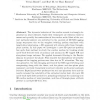Free Online Productivity Tools
i2Speak
i2Symbol
i2OCR
iTex2Img
iWeb2Print
iWeb2Shot
i2Type
iPdf2Split
iPdf2Merge
i2Bopomofo
i2Arabic
i2Style
i2Image
i2PDF
iLatex2Rtf
Sci2ools
SCALESPACE
2009
Springer
2009
Springer
A Multi-scale Feature Based Optic Flow Method for 3D Cardiac Motion Estimation
Abstract. The dynamic behavior of the cardiac muscle is strongly dependent on heart diseases. Optic flow techniques are essential tools to assess and quantify the contraction of the cardiac walls. Most of the current methods however are restricted to the analysis of 2D MR-tagging image sequences: due to the complex twisting motion combined with longitudinal shortening, a 2D approach will always suffer from throughplane motion. In this paper we investigate a new 3D aperture-problem free optic flow method to study the cardiac motion by tracking stable multi-scale features such as maxima and minima on 3D tagged MR and sine-phase image volumes. We applied harmonic filtering in the Fourier domain to measure the phase. This removes the dependency of intensity changes of the tagging pattern over time due to T1 relaxation. The regular geometry, the size-changing patterns of the MR-tags stretching and compressing along with the tissue, and the phase- and sine-phase plots represent a suitabl...
| Added | 27 May 2010 |
| Updated | 27 May 2010 |
| Type | Conference |
| Year | 2009 |
| Where | SCALESPACE |
| Authors | Alessandro Becciu, Hans C. van Assen, Luc Florack, Sebastian Kozerke, Vivian Roode, Bart M. ter Haar Romeny |
Comments (0)

